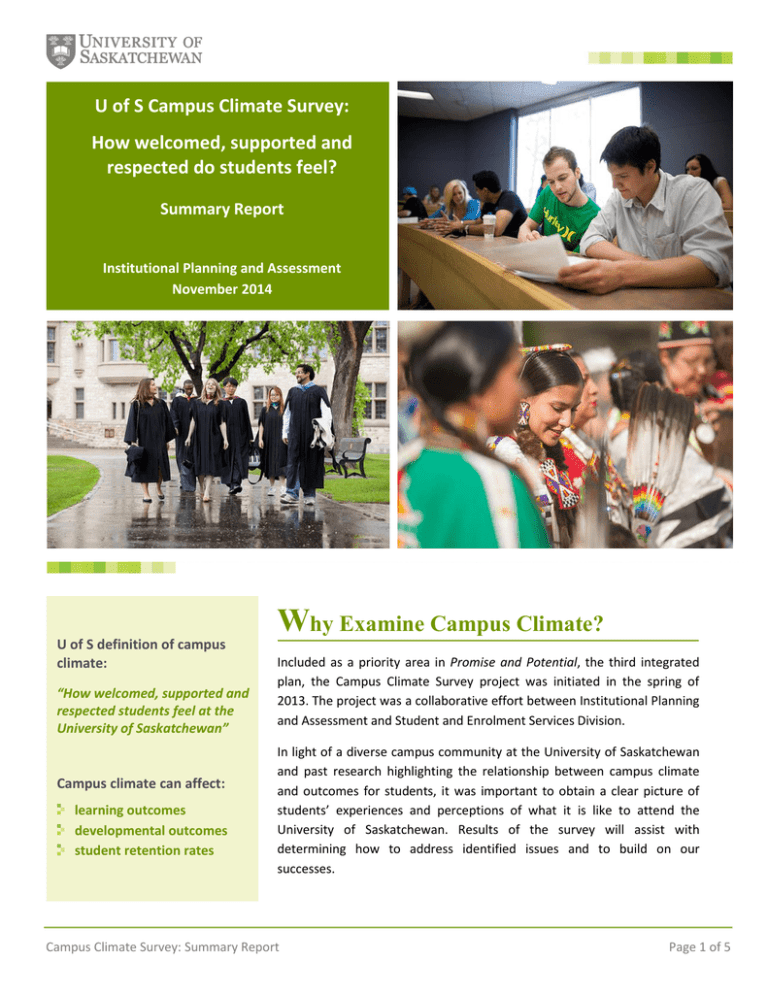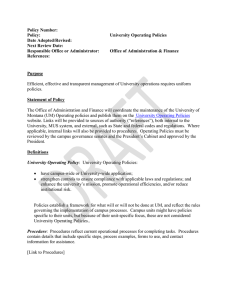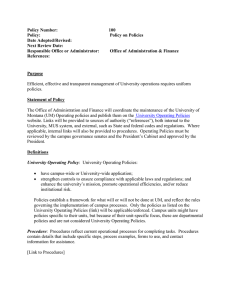
U of S Campus Climate Survey:
How welcomed, supported and
respected do students feel?
Summary Report
Institutional Planning and Assessment
November 2014
U of S definition of campus
climate:
“How welcomed, supported and
respected students feel at the
University of Saskatchewan”
Campus climate can affect:
learning outcomes
developmental outcomes
student retention rates
Why Examine Campus Climate?
Included as a priority area in Promise and Potential, the third integrated
plan, the Campus Climate Survey project was initiated in the spring of
2013. The project was a collaborative effort between Institutional Planning
and Assessment and Student and Enrolment Services Division.
In light of a diverse campus community at the University of Saskatchewan
and past research highlighting the relationship between campus climate
and outcomes for students, it was important to obtain a clear picture of
students’ experiences and perceptions of what it is like to attend the
University of Saskatchewan. Results of the survey will assist with
determining how to address identified issues and to build on our
successes.
Campus Climate Survey: Summary Report
Page 1 of 5
Who Participated?
21,027 students were invited to participate.
5,205 students completed the survey, representing a 25% response
rate.
The survey sample was largely representative of the student
population and represented the diversity of students at the U of S.
Description of Participants
Demographics
The Survey
The Campus Climate Survey (CCS) was
developed based on an extensive literature
review of the topic and of campus climate
surveys implemented at other postsecondary institutions.
The online survey included questions
pertaining to five main areas:
Overall campus climate (e.g., sense of
belonging, institutional commitment to
diversity, etc.)
Campus experiences (e.g.,
witnessing/experiencing insensitive
behaviour, exclusion, harassment and
discrimination)
Classroom experiences and
interactions with staff/faculty
Helpfulness of support services
How to improve campus climate
The survey mainly included closed-ended
questions but there were also many
opportunities to provide additional
comments.
Campus Climate Survey: Summary Report
Categories
#
%
Gender
Female
Male
2,682
1,621
62%
38%
Age
(average = 24)
Under 20
20-25
26-40
Over 40
1,044
2,238
891
117
24%
52%
21%
3%
Sexual Orientation
Heterosexual
Sexual Minority
3,579
310
92%
8%
Ethnicity
White/Caucasian
Visible minority
Aboriginal
3,050
914
367
70%
21%
9%
Religious/Spiritual
Affiliation
Non-affiliated
Christian
Other than Christian
1,583
1,991
702
37%
47%
16%
Political Views
Liberal/far left
Middle of the road
Conservative/far right
1,596
1,768
844
38%
42%
20%
Parental Status
No children
Children (under 18 yrs)
3,922
354
92%
8%
Disability Status
No disability
Physical disability
Learning disability
Mental health condition
3,502
187
159
269
87%
5%
4%
7%
International Student Status
Domestic student
International student
3,875
486
89%
11%
Program Level
Undergraduate
Graduate
3,595
789
82%
18%
Page 2 of 5
Key Findings: Areas of Strength
1. Satisfied with overall campus climate
76% of students felt the U of S was
committed to the issue of diversity and
many partook in activities promoting
diversity.
The majority of students felt safe (71%) and
comfortable (79%) on campus.
76% of students were satisfied with their
academic experience and 80% were likely to
recommend the university to others.
2. Positive experiences in the classroom and
interactions with staff and faculty
77% of undergraduates and 79% of graduate
students reported they felt comfortable/very
comfortable in the classroom.
The majority of students felt they were
treated fairly by staff (90%), professors (89%)
and teaching assistants (84%).
Undergraduates and graduate students had
very positive experiences with their thesis
advisors. For example, 88% felt that they
were treated with respect by their thesis
advisor.
“I've been here for 7 years and I have seen incredible growth
regarding inclusion, multicultural opportunities, and a proactive
approach to diversity in and outside the classrooms.”
“I can still remember my very first day at the U of S - it was the
only place I had ever felt like I belonged. I still feel that way. It's
my home and where the people I love to be around are.”
3. Low incidence of experiencing negative behaviours
on campus
Very few students indicated they experienced
harassment (6%), exclusion (11%), or
discrimination (11%).
A minority of students (15%) believed sexual
harassment and sexual assault are a problem at
the U of S.
4. Satisfaction with support services
All student centres received a rating of 3.5 (out
of 5) or higher, suggesting students were
satisfied with the services they utilized.
Of the other services asked about, library
services received the highest rating (4.3 out of
5).
“[Name of professor] is an amazing person to have on campus. She is an excellent mentor
and persistent in her efforts to make this campus a better place for Aboriginal students,
both academically and otherwise.”
“The climate of the program has always been sensitive toward diversity. The material we
learn emphasizes being aware of potential discrimination or bias toward a person
because of their race, sexuality, education, [socioeconomic status], etc. The professors
always modeled acceptance and sensitivity.”
“It is a pleasure working with my supervisor because he is extremely knowledgeable in my
topic area and is renowned for his work, but also because he is a fair and kind man who
respects me, other students and staff, and my work.”
Campus Climate Survey: Summary Report
Page 3 of 5
Key Findings: Areas for Improvement
1. Some students in minority groups had
less positive experiences when
compared to their counterparts,
especially some Aboriginal students,
other visible minority students, sexual
minority students, and some students
with a disability. On average, those
indicating a mental health condition
generally had fewer positive
experiences than all other students.
57% of those with a mental health
condition reported they either
considered leaving or did leave the U
of S.
Those with a mental health condition
and sexual minority students were
twice as likely to report experiencing
insensitive behaviour, exclusion,
harassment and/or discrimination as
compared to the overall survey
population.
“Most insensitive behaviour that I have seen
has been in jokes and language that people use.
It almost seems as though people say such
things without thought of how their words are
affecting others.”
“…mental health concerns are still deeply
stigmatized and students are not encouraged to
discuss these matters when they are affecting
their academic performance.”
“Faculty and Staff VERY often presume that an
individual is heterosexual which is problematic.
When one discovers an individual is not
heterosexual, the typical response is "you're
gay...you don't seem gay!" as if that somehow
constitutes a compliment.”
2. Some students were unsure of where to
go for help or were afraid of negative
consequences if they reported an
incident.
Negative behaviours were most often
experienced and/or witnessed based
on race/ethnicity and English
language proficiency.
Those with a mental health condition
were most likely to feel sexual
harassment and sexual assault are
issues at the U of S (27% and 28%,
respectively).
Sexual minority students and those
with a mental health condition were
more likely to report having negative
experiences in the classroom.
“People I know who have experienced discrimination
or harassment have not known the process of
reporting this behaviour and have not wanted to
investigate for fear of being found out and being on
the receiving end of reprisals.”
Campus Climate Survey: Summary Report
When asked how they reacted to
negative behaviours, students most
often ignored it or talked to a friend
(45% to 54%). Very few indicated they
reported the incident(s) (2% to 8%).
Overall, the campus
climate was perceived
positively by most of
the survey respondents.
However, it was also
found that:
some students in
minority groups
had less positive
experiences
some students
were unsure of
where to go for
help or were afraid
of negative
consequences if
they reported an
incident
feelings of reverse
discrimination were
expressed
Just under half of students reported
they would know where to go for help
if they or a friend were sexually
harassed or sexually assaulted.
Only 19% of students understood the U
of S’s formal procedures for addressing
complaints of sexual harassment or
sexual assault.
Nearly one-third of students were
unlikely to turn to their professors
or staff for help with personal
matters.
(continued)
Page 4 of 5
3. Feelings of reverse discrimination and special
treatment of minority groups were expressed by some
members of the majority group.
Additional comments were provided pertaining to the
belief that minority groups receive additional
supports and academic advantages.
Some participants felt they were victims of reverse
discrimination on the basis of gender and
ethnicity/race.
Key Findings: Enhancing Campus Climate
From a list of five options, survey respondents were
most likely to endorse providing diversity training for
staff and faculty (59% agreed/strongly agreed) and least
likely to endorse providing diversity training for
students (47% agreed/strongly agreed).
Other suggestions for enhancing campus climate
centered around the university providing more
opportunities to interact with other students, to better
inform students of existing services and groups, and to
provide additional supports.
“Have a multicultural week celebrating the diversity of all students
at U of S. It can include fashion/talent show, dances, cultural
displays, etc. from all ethnic clubs at the university. This was done
at my previous university every year with great success promoting
multiculturalism and was fun to watch.”
“Have a campus community club night where all clubs gather to
show new and current students what groups they could belong to if
they want. It would help others appreciate the diversity we see on
campus.”
What’s Next?
In order to address the findings of the campus climate survey, the following steps are necessary:
Gain a deeper understanding of the experiences of
minority group students, paying particular attention to
those with mental health conditions.
Examine how the process of reporting incidents is
communicated to students and address beliefs that
reporting will lead to negative repercussions.
Further examine the experiences of majority group
members and help ensure reverse discrimination and
the belief that minority group students receive special
treatment are addressed.
Campus Climate Survey: Summary Report
Develop a plan of action in relation to the identified
issues.
Continue implementing campus climate surveys to
determine the success of initiatives and to identify
emerging issues facing students.
Include staff and faculty in future iterations of the
campus climate survey.
To learn more about the Campus Climate Survey
project and to view the full report visit:
http://www.usask.ca/ipa/assessment/campus_climate_sur
vey/index.php
Page 5 of 5




